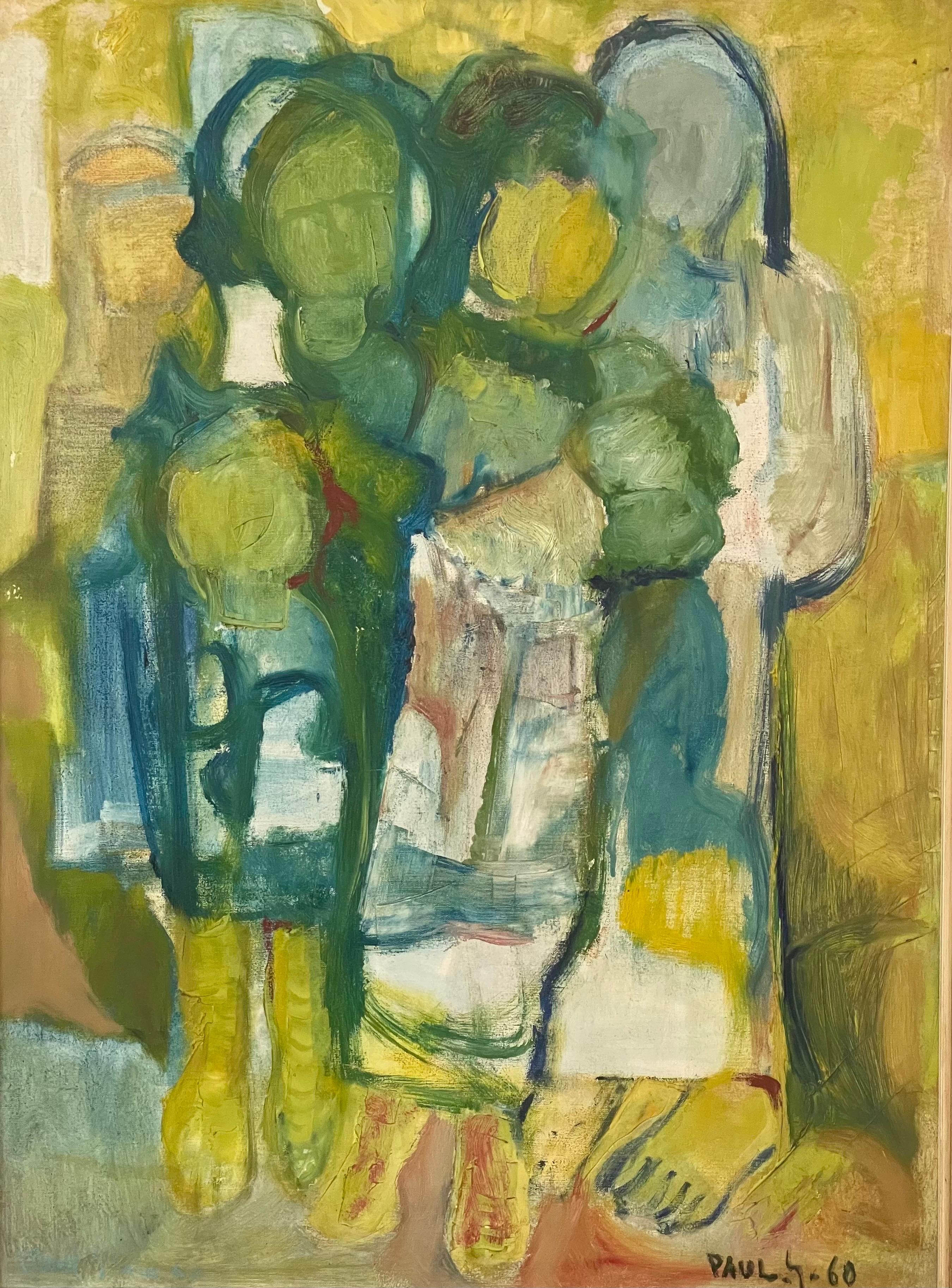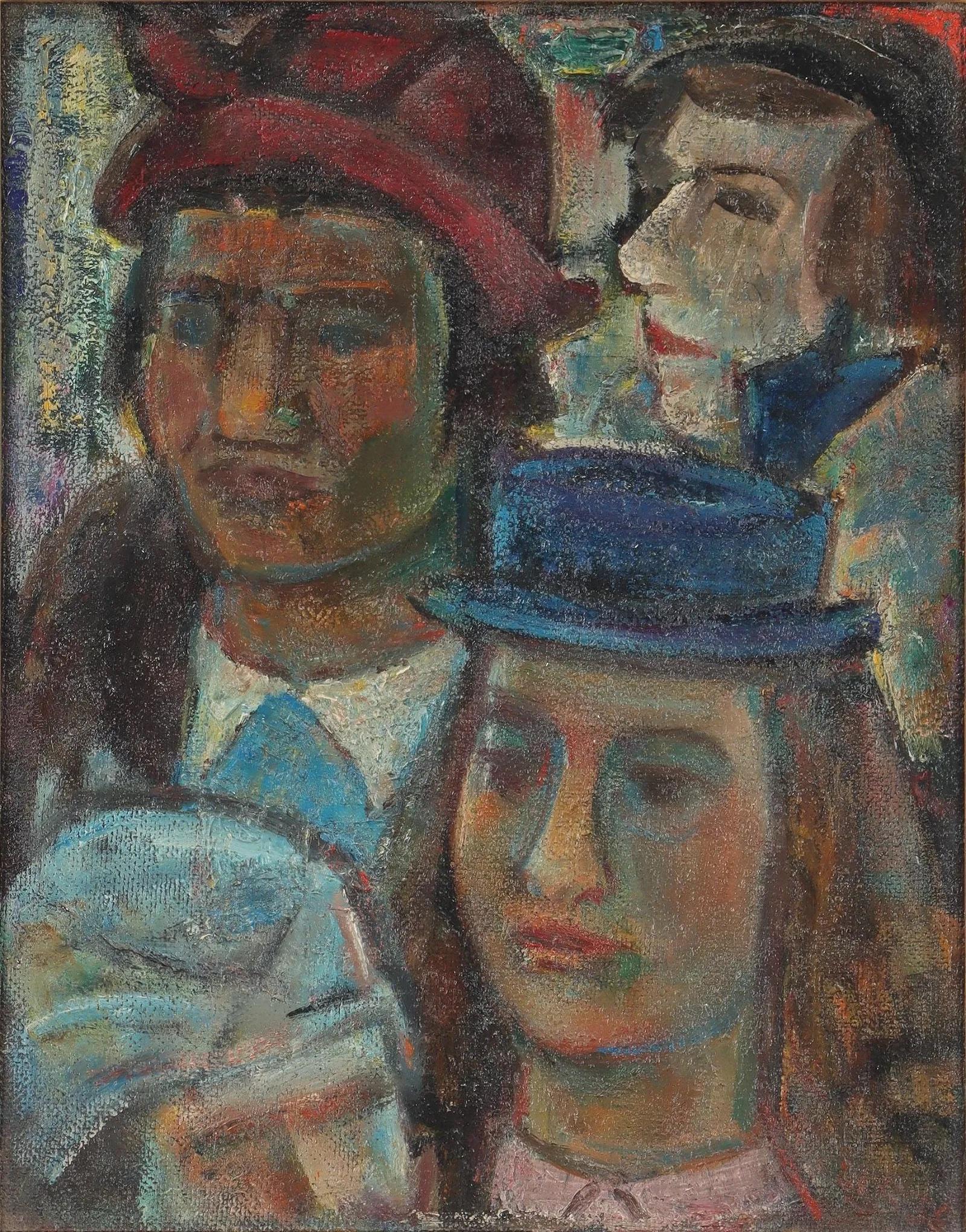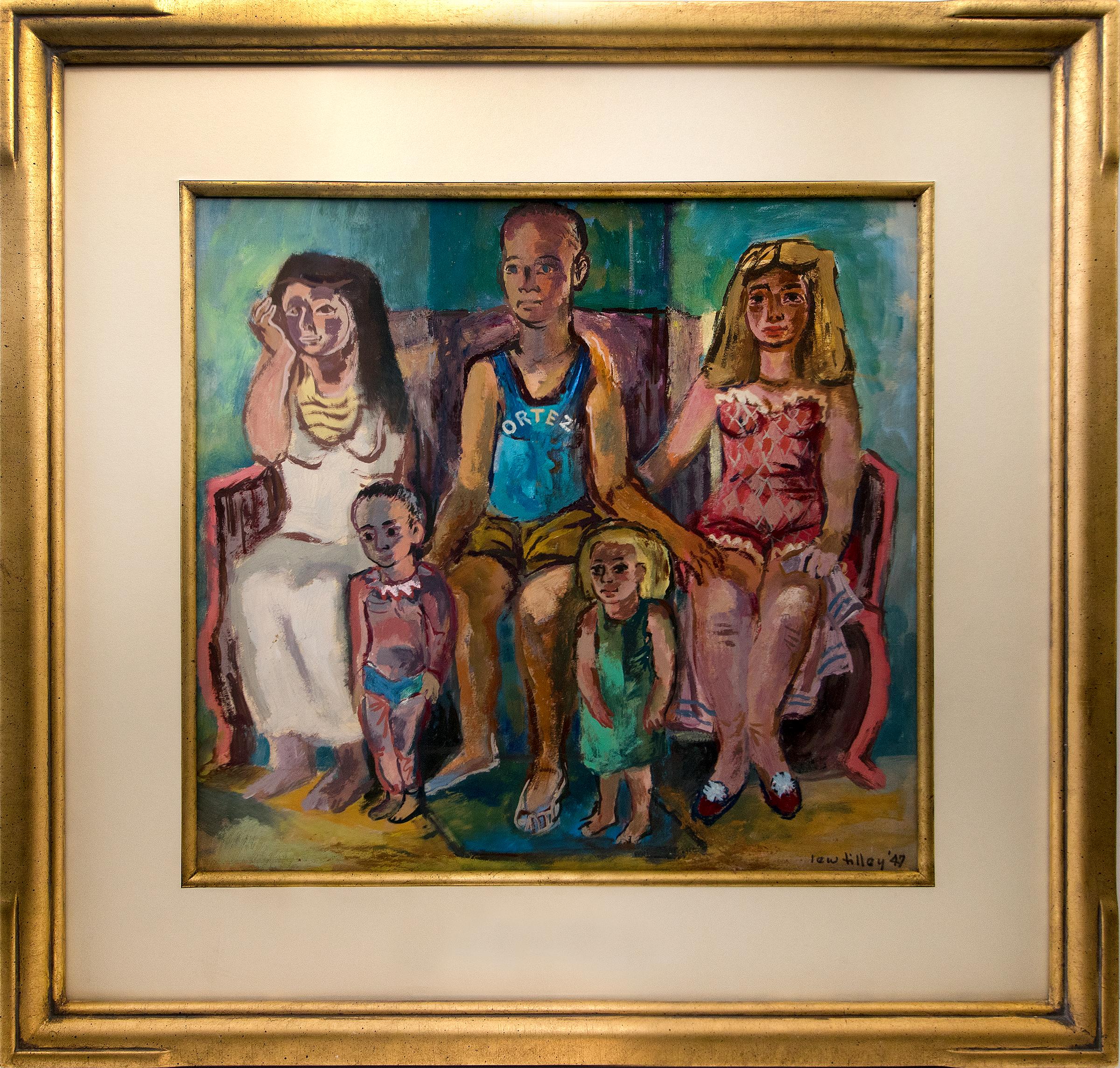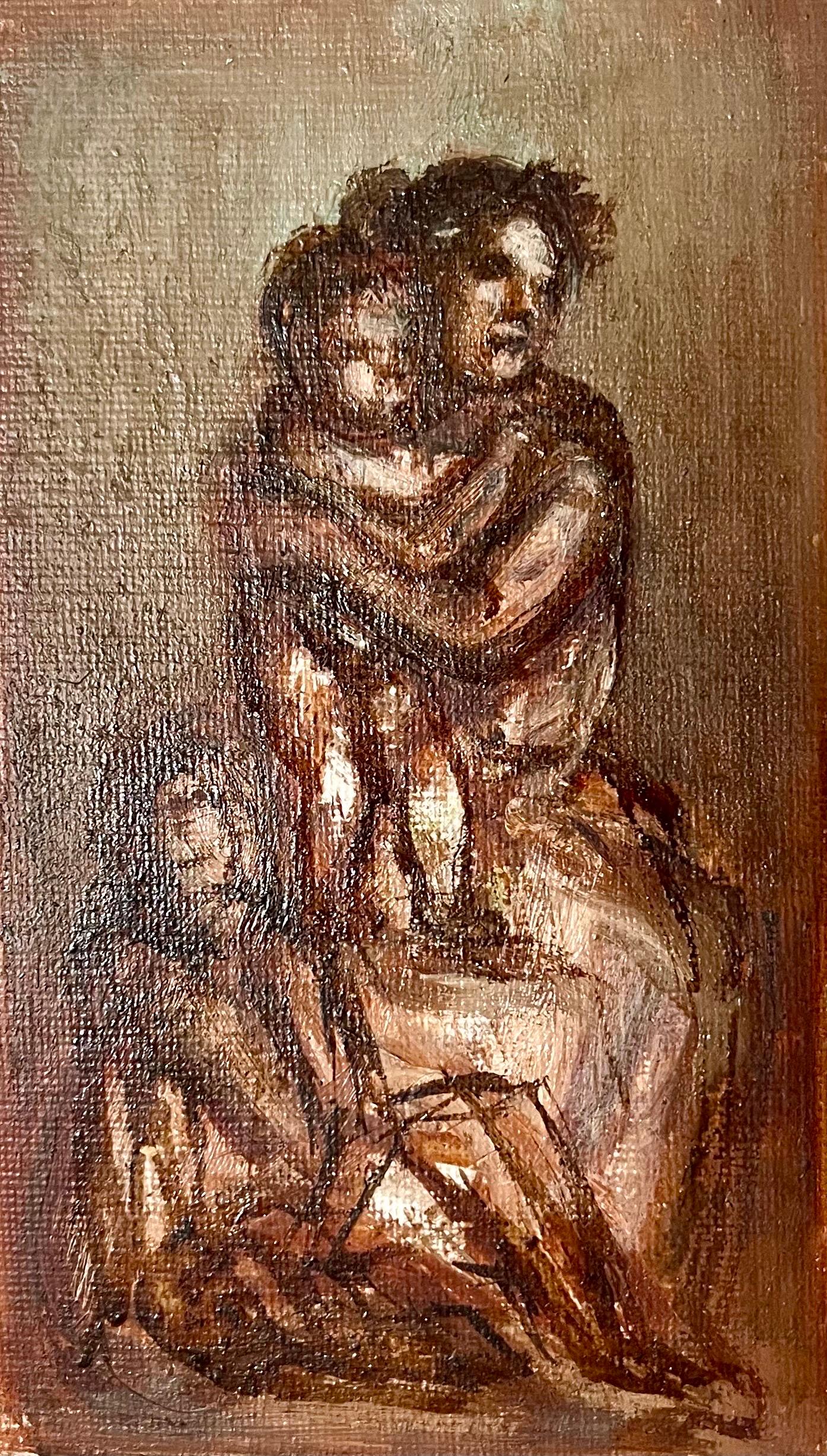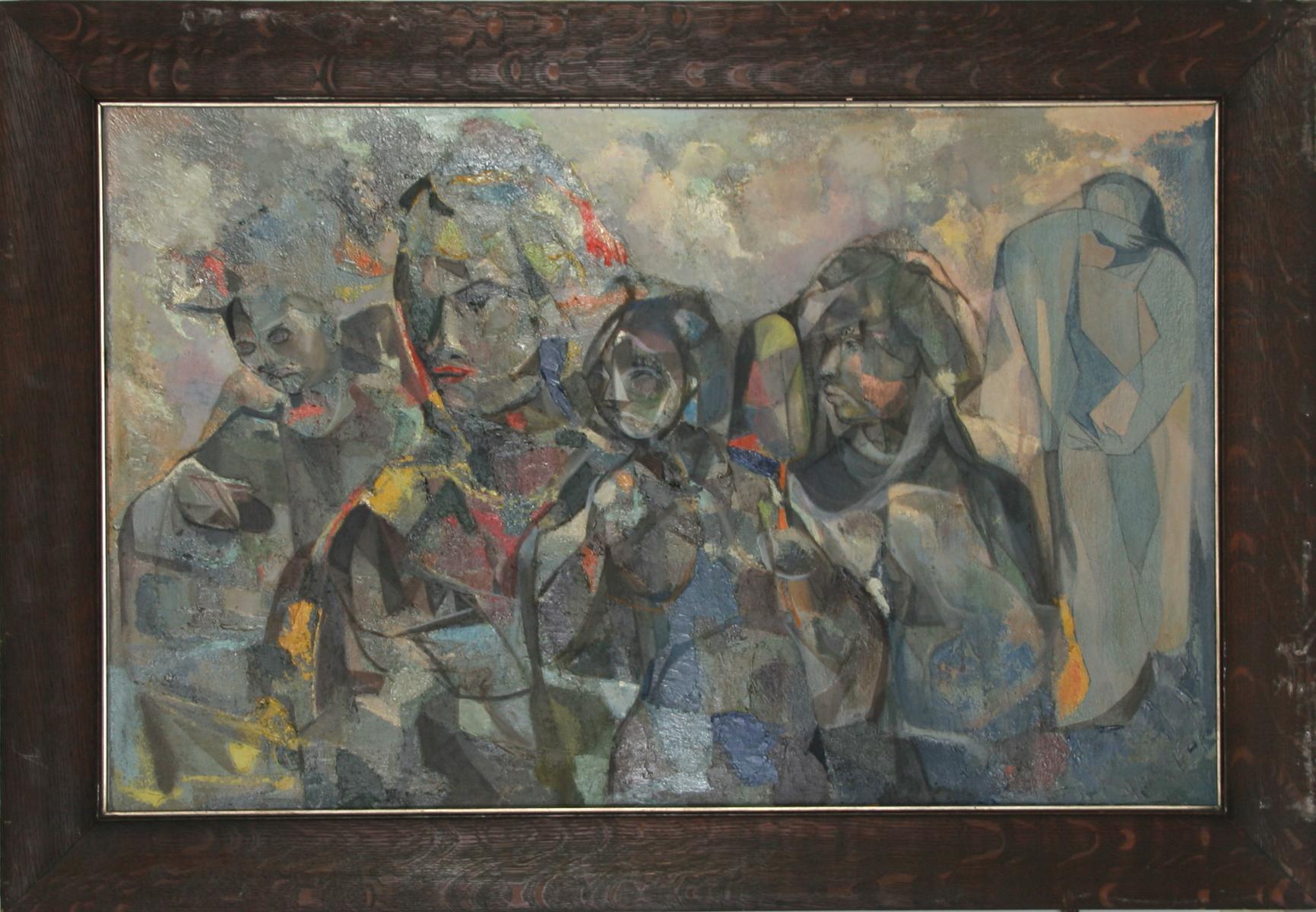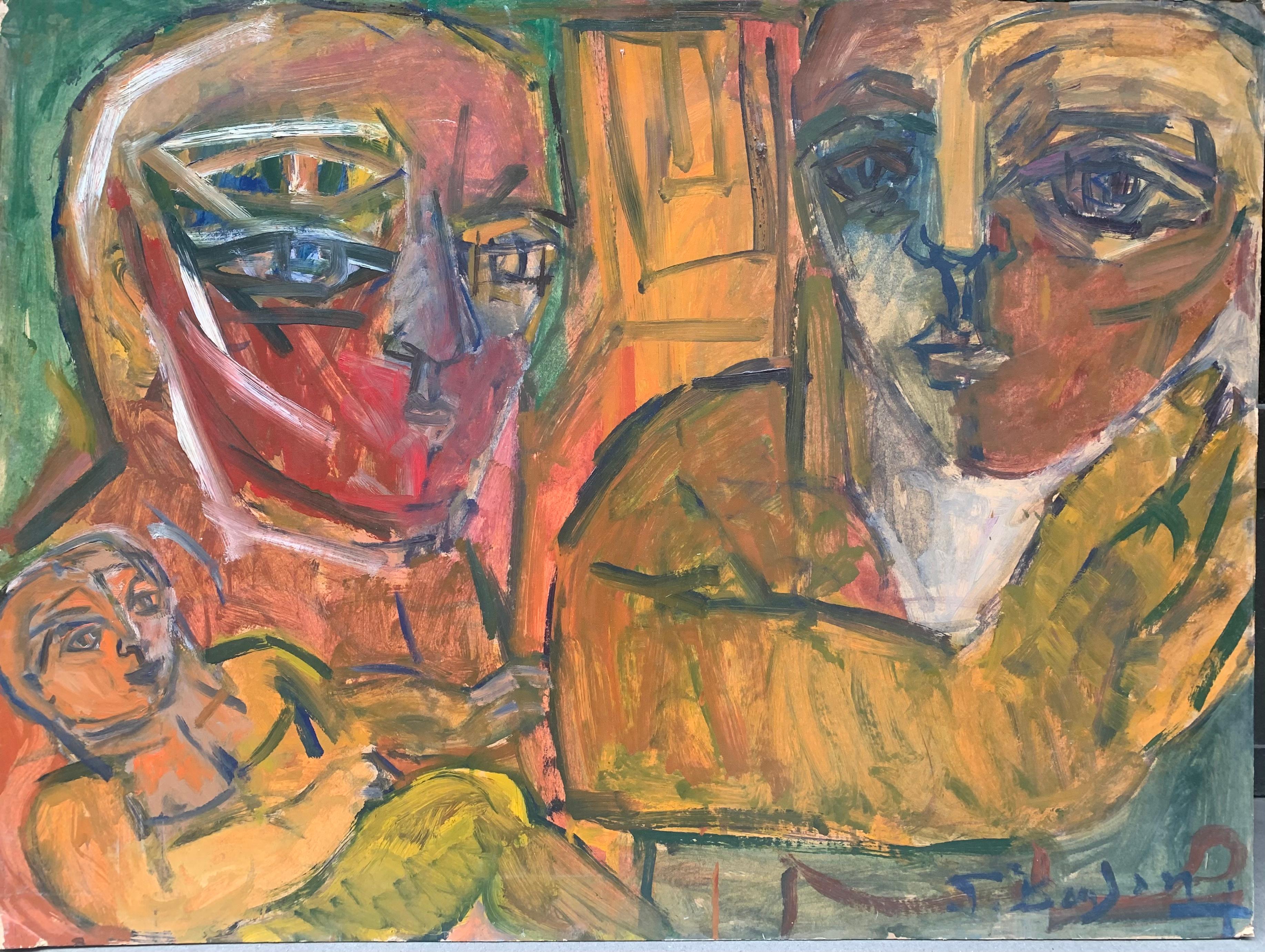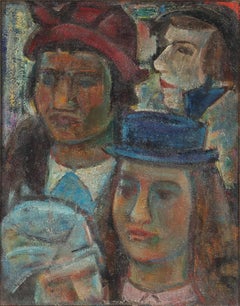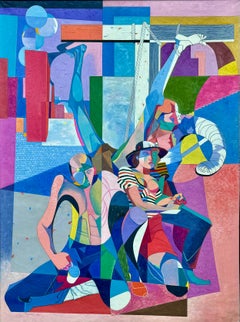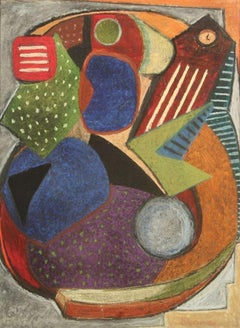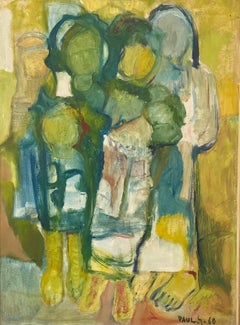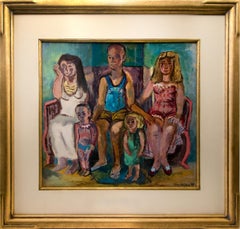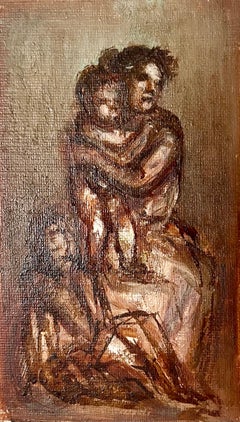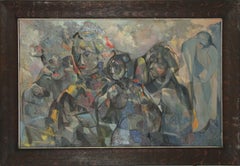Items Similar to "The Faces We Wore" WPA Family American Scene Figurative Abstract Woman Artist
Want more images or videos?
Request additional images or videos from the seller
1 of 9
Juanita Guccione"The Faces We Wore" WPA Family American Scene Figurative Abstract Woman Artist1935
1935
$160,000
£121,654.34
€140,147.51
CA$227,477.95
A$247,229.40
CHF 130,651.07
MX$2,990,942.08
NOK 1,627,166.02
SEK 1,536,959.50
DKK 1,046,359.74
About the Item
"The Faces We Wore" WPA Family American Scene Figurative Abstract Woman Artist
Juanita Guccione (1904 - 1999)
The Faces We Wore
20 x 16 inches
Oil on canvas
Signed, titled and dated 1935 verso
Framed: 27 1/2 x 23 1/4
Provenance:
Estate of the artist.. Acquired directly from the artist's son, Del Marbrook.
The painting is in very good condition. It was framed by Heydenryk decades ago and the frame could use a touch up.
Note: In addition to this oil painting we currently have an abstract drawing listed. We have several other drawings, along with a major surrealist oil, by Guccione, none of which are currently listed. Inquiries are invited.
BIO
The following is from Djelloul (Del) Marbrook, son of the artist. Of signatures on paintings by his mother, Juanita first signed as Anita Rice, then as Juanita Rice, Juanita Rice Marbrook, Juanita Marbrook, and finally Juanita Guccione after marrying in the 1940s.
Juanita Guccione's life (June 20, 1904-December 18, 1999) spanned all but four years of the 20th Century. Cubist*, realist, surrealist*, automatist* and abstract strains are all to be found in her work, but by 1970 she was painting works in watercolor and acrylic that no longer included the human figure or the observed world. She was the younger sister of the abstract geometric* artist Irene Rice Pereira. The sisters were born in Chelsea, MA, but spent most of their working lives in Manhattan.
In the early 1930s, Guccione, then painting as Nita Rice, lived for four years among the Ouled Nail Bedouin tribe in eastern Algeria. Her paintings from this period are devoid of the flamboyant romanticism of the Orientalist* painters. She painted the Bedouin as friends and neighbors, reflecting the anti-colonialist attitude of her native land. These paintings were shown in The Brooklyn Museum in 1935.
When she returned from Algeria in 1935 the United States was in economic free-fall. After the Brooklyn Museum exhibit the Algerian work was shut away as she immersed herself in an avant-garde then fomenting revolutionary artistic changes. Guccione began painting as Anita Rice, changed her name to Juanita Rice, then to Juanita Marbrook, and finally to Juanita Guccione after marrying Dominick J. Guccione in the mid-1940s.
Guccione worked on Post Office murals for the WPA* Federal Works Progress Administration during the 1930s. During World War II she came under the influence of the refugee French surrealists. She studied with Hans Hofmann for seven years. Hofmann expressed high regard for her work and gave her a number of scholarships. Her mid-career surrealist paintings do not share the literary interests of many of her European contemporaries. They portray a magical and whimsical world ruled by women. Their brilliant palette, though not their subject matter, reflects Hofmann's influence.
Guccione's work was shown in Manhattan, Paris, Beirut, Bombay, San Francisco, Washington, Provincetown, PalBeach, Pittsburgh, Miami, Algiers and other Algerian cities.
She was unusually reclusive, and this trait often thwarted enthusiasts attempting to promote and celebrate her work. Her reclusiveness, her name changes, and the critics' difficulty in characterizing her work deprived her of the recognition she might otherwise have received.
Nonetheless, the respected French novelist and critic Michel Georges-Michel wrote in the early 1950s that she was one of a very few American artists who interested him, this at a time when abstract expressionism* was the rage and America was establishing its claim to importance in taste-making.
Describing her long career, the former Washington Post art critic Michael Welzenbach wrote in 1992: "This kind of artistic evolution hardly fits into the inimically popular contemporary trend of modifying one's style to keep abreast of fashionable changes in the mainstream art world. And it is precisely this single-minded approach to her work, this willingness to follow its development wherever that might lead, that locates Guccione squarely among the few but formidable ranks of the modernist avant-garde--a group whose integrity and vision will not be seen again in this century."
No one, probably not even Guccione, reckoned how prolific and restless her career had been until her works were collected after her death. Her reputation had come to rest on the surrealist oils of her middle years, while the more abstract and adventurous acrylic and watercolor work of her later years was little known.
The extraordinarily reticent artist hinted at her own view of her later work when she wrote to a purchaser that she did not imagine the work, she saw it.
Guccione was a respected teacher, perhaps because of her reticence. She was able to impart ideas and techniques by guiding her students' hands and by working alongside them, rather than lecturing them. She taught at the Art Students League* and at Cooper Union*.
The large body of work she left poses a special challenge to feminists because she created in her middle years a peaceable otherworld ruled entirely by women. Of feminists she was fond of remarking, "I'm not at all interested in what they say, only in what they do."
The French writer and poet Anais Nin, whose portrait Guccione painted several times, said of her work, "Our dreams are often diffuse and fragmented. Juanita makes them cohesive and clear, as clear as the daily world. Few people can paint the world of our dreams with as much magic, precision, and clarity. It makes the myths by which we live as vivid and dramatic as our diurnal life."
- Creator:Juanita Guccione (1904 - 1999, American)
- Creation Year:1935
- Dimensions:Height: 28 in (71.12 cm)Width: 24 in (60.96 cm)Depth: 2 in (5.08 cm)
- Medium:
- Movement & Style:
- Period:
- Condition:
- Gallery Location:New York, NY
- Reference Number:1stDibs: LU1156215855982
About the Seller
5.0
Gold Seller
Premium sellers maintaining a 4.3+ rating and 24-hour response times
Established in 2008
1stDibs seller since 2019
195 sales on 1stDibs
Typical response time: <1 hour
- ShippingRetrieving quote...Shipping from: New York, NY
- Return Policy
Authenticity Guarantee
In the unlikely event there’s an issue with an item’s authenticity, contact us within 1 year for a full refund. DetailsMoney-Back Guarantee
If your item is not as described, is damaged in transit, or does not arrive, contact us within 7 days for a full refund. Details24-Hour Cancellation
You have a 24-hour grace period in which to reconsider your purchase, with no questions asked.Vetted Professional Sellers
Our world-class sellers must adhere to strict standards for service and quality, maintaining the integrity of our listings.Price-Match Guarantee
If you find that a seller listed the same item for a lower price elsewhere, we’ll match it.Trusted Global Delivery
Our best-in-class carrier network provides specialized shipping options worldwide, including custom delivery.More From This Seller
View AllNeon Lighting WPA Mid 20th Century Social Realism American Scene Modern Figures
By Maurice Becker
Located in New York, NY
Neon Lighting WPA Mid 20th Century Social Realism American Scene Modern Figures
MAURICE BECKER (1889-1975)
'Neon Lighting
17 1/4 x 13 3/4 inches
Oil on masonite
Signed, dated 1936 and titled on verso
BIO
Maurice Becker, painter, political cartoonist and social reformer, was born in 1889 either in Gorky or Niznij Novgorod, in Russia. His family came to the United States in 1892, to New York City. After high school, Becker worked in a clothing factory. He studied with Ash Can School artist Robert Henri in 1908, and exhibited in the famous 1913 Armory Show in New York City when he was only twenty-four years of age.
At the Armory show, Becker showed a drawing of a dog's head...
Category
1930s American Modern Figurative Paintings
Materials
Masonite, Oil
Figurative Cubist Surrealist Abstraction Mid 20th Century American Modern Large
By O. Louis Guglielmi
Located in New York, NY
Figurative Cubist Surrealist Abstraction Mid 20th Century American Modern Large
O. Louis Guglielmi (1906 - 1956)
OBSESSIVE THEME
44 x 33 inches
Oil on canvas
Signed and dated '48 lo...
Category
1940s American Modern Abstract Paintings
Materials
Canvas, Oil
Abstract Mid 20th Century WPA Non Objective American Modernism New Hope Modern
By Louis Stone
Located in New York, NY
Abstract Mid 20th Century WPA Non Objective American Modernism New Hope Modern.mixed media. 21 x 16 (sight). Housed in a hand carved frame.
Louis King Stone ...
Category
1940s American Modern Mixed Media
Materials
Gouache, Board
WPA Mural Study American Scene Social Realism Mid 20th Century Modern Workers
By Seymour Fogel
Located in New York, NY
WPA Mural Study American Scene Social Realism Mid 20th Century Modern Workers
Seymour Fogel (1911-1984)
Mural Study, untitled
11 x 49 1/4 inches (sight)
Tempera on board
Provenance:...
Category
1930s American Modern Figurative Paintings
Materials
Egg Tempera, Board
"Abstraction" Mid 20th Century American Abstract 1960s Color Field
Located in New York, NY
"Abstraction" Mid 20th Century American Abstract 1960s Color Field
James Daugherty (1887 – 1974)
Abstraction
16 x 12 inches
Estate stamp verso
Oil on panel
Provenance: Estate of t...
Category
1960s Abstract Abstract Paintings
Materials
Oil, Panel
Abstract Non Objective Mid 20th Century American Modern Color Field 1950s
Located in New York, NY
Abstract Non Objective Mid 20th Century American Modern Color Field 1950s
James Daugherty (1887 – 1974)
Abstraction
84-1/2 x 42-1/2 inches
Signed and ...
Category
1950s Abstract Abstract Paintings
Materials
Canvas, Oil
You May Also Like
Contemporary art, the family, figures, Paul Guiragossian.
By Paul Guiragossian
Located in La Canada Flintridge, CA
Here is one of Paul Guiragossian's 1960s oil paintings on canvas. The artwork's size, without the frame, is 31 x 23 inches. The overall composition represents a family, with the figu...
Category
1960s Abstract Expressionist Figurative Paintings
Materials
Oil
1947 Modernist Family Portrait Gouache by Lewis Lee Tilley, Framed Artwork
Located in Denver, CO
Ortez (Modernist Family Portrait) is a vibrant 1947 abstract gouache on paper by American artist Lewis Lee Tilley (1921–2005). This dynamic composition captures a family of five seat...
Category
1940s American Modern Portrait Paintings
Materials
Paper, Gouache
$1,950 Sale Price
31% Off
Simka Simkhovitch WPA Artist Oil Painting Family Mother, Kids American Modernist
By Simka Simkhovitch
Located in Surfside, FL
Simka Simkhovitch (Russian/American 1893 - 1949)
This came with a small grouping from the artist's family, some were hand signed some were not.
These were studies for larger paintin...
Category
1930s American Modern Figurative Paintings
Materials
Oil, Board
Figures, Cubist Oil on Board Painting by John F. Leonard
Located in Long Island City, NY
Figures (66)
John F. Leonard
American (1921–1987)
Date: circa 1965
Oil on Board
Size: 21 in. x 33 in. (53.34 cm x 83.82 cm)
Frame Size: 27 x 41 inches
Category
1960s Cubist Figurative Paintings
Materials
Oil, Board
Patrick Boudon. Inner Family. Post-war Expressionism. 1970s.
By Patrick Boudon
Located in Firenze, IT
Patrick Boudon.
Inner Family.
Post-war Expressionism.
1970s.
Patrick Boudon.
Art Informel. Ecole de Paris.
Technique: oil on cardboard.
This painting by Patrick Boudon from the 197...
Category
1970s Expressionist Figurative Paintings
Materials
Oil, Cardboard
$475 Sale Price
20% Off
Free Shipping
Early American Modernist Abstract Expressionist Figural Framed Oil Painting
Located in Buffalo, NY
Antique American modernist abstract oil painting by Eugene Arcieri (1914 - 2005). Oil on board. Framed. Signed. Measuring 15 by 19 inches overall and 14 by 18 painting alone. In exce...
Category
1960s Modern Abstract Paintings
Materials
Oil, Board
More Ways To Browse
Modern Abstract Faces
Algeria Painting
Heydenryk Frames
Michel Georges Michel
Abstract Woman Face
Juanita Guccione
Oil Paintings Paris Cafe
Paintings By Esther
Rebecca Johnson
Rene Smoorenburg
Rob Alexander
Salome With The Head Of John The Baptist
Samantha Buller
Street Art Painting Basquiat
Susanna And The Elders
Tamar Sulakvelidze
Tea Time Painting
Tomas Sunyol
